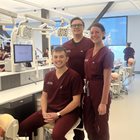Despite many advances in medicine, septic shock remains a serious illness with a mortality rate exceeding 30 percent among patients who receive treatment and resulting in more than 200,000 deaths each year in the United States alone. However, an ongoing study conducted by Kansas City University (KCU) third-year medical student Takara Newsome-Cuby in collaboration with a research team from University of Missouri-Kansas City, shows much promise.
Their research titled “Increased Survivability and Improved Kidney Function in Septic Shock Patients Treated with Phospholipid Nanoparticles (VBI-S)” used a clinical trial with 20 bacterial sepsis patients over the age of 18. VBI-S is a patented hydrophobic fluid composed of a unique combination of liposomes and micelles. While the precise mechanism of action of these nanoparticles is a subject of continued research, the team’s hypothesis focused on the ability of these nanoparticles to facilitate the redistribution of nitric oxide, a potent vasodilator in the human body.
During the study, patients received a maximum infusion of 1500 milliliters of VBI-S over a 24-hour period, maintaining a constant infusion rate of 999 milliliters per hour. To initiate the treatment, the team administered an initial dose of 100 milliliters and doubled the dosage until the primary objective of elevating the mean arterial pressure (MAP) to reverse shock was successfully attained. The results were incredible. The team found that VBI-S increased MAP while effectively decreasing the need for vasopressor medications; increased kidney function; improved survivability of 14 of the 20 patients studied; and observed no severe adverse effects.
The team has transitioned to the next phase of their research. In July, they secured approval for a phase IIb/III clinical trial with a larger enrollment target of 34 patients. If the data continues to demonstrate consistent results, they will begin exploring the possibility of bringing the drug to market with an indication for both relative and absolute hypovolemia. This paves the way for the potential availability of the drug within a couple of years, offering promising treatment options for patients dealing with hemorrhagic and septic shock.
The research gained significant exposure when Newsome-Cuby was the only medical student invited for a podium presentation during the National Medical Association’s Annual Convention and Scientific Assembly held in New Orleans, Louisiana. The event serves as the nation’s foremost forum on medical science and African American health. Each year, African American physicians and other health professionals from around the country convene to participate in the scholarly exchange of medical advances. The convention attracts the broadest spectrum of African American physicians, academics and scientists in the nation.
Next, Newsome-Cuby traveled to Ann Arbor, Michigan, to give an oral presentation of the study during The Society of Black Academic Surgeons Annual Meeting where she took first place. “I am both deeply honored and humbled by all of this. Each step of this research journey has reinforced my commitment to becoming a competent physician with the capability to effect positive change in health care,” remarked Newsome-Cuby. “Receiving such impressive accolades for our research is incredibly gratifying. I never initially anticipated invitations to national conferences, awards, or publications as a result. However, it’s truly fulfilling to witness the recognition of the groundbreaking science we’ve been conducting, knowing that it holds the potential to make a meaningful impact and save lives.”
In addition to her research endeavors, Newsome-Cuby also serves as National Membership Committee vice chair of the Student National Medical Association and as the Critical Mass Gathering Research Committee chair for Mission Vision Project KC, an initiative striving to increase the number of underrepresented minorities in health sciences and retained in the Kansas City Metro health care workforce.
_20231018210214_0.jpg)


